For a long time, I’ve been obsessed with salt tectonics. Less from a geological perspective, more from an aesthetic one. I understand that salt (and other evaporites?) behave in freaky ways. Under a bit of pressure, including the pressure of further layers of deposition, it can roll and buckle and fold and swoosh up like a mushroom cloud.
So when I first saw images of exposed swirly salt near the Dead Sea in Israel, I knew I had to see them in person.

Having my photo taken in the Dead Sea, reading dead tree media has always been on my bucket list, so it seemed like a win-win. Cool rocks and a photo op.
Mark and I had been planning to visit Israel in November of 2023. Not planning hard enough to book tickets, but planning enough to make a list of things I wanted to see and look at options. And then it seemed like it was not such a good idea to be in the South of Israel.
That doesn’t mean I won’t go. I will go, and soon-ish. Local difficulties don’t stop me looking at pictures or using one of those images to make a print. I found the amazing collection of photos from Professor Ram Weinberger. It’s so much more than salt. So, I wrote to him and asked permission to use some of his photos and he was kind enough to agree.
I worked on two images, though it was tough to choose. Of course I chose some salt deformation, but the outcrop was fairly weathered, so I used some artistic license to create a fresh face. I’m still having some problems creating the perspective I’d like to achieve.


I also chose an image of the Hazera monocline. Again, my initial images didn’t tell the story of the folding as I would have liked.


So what do you do when you have a problem turning rocks into art? You call Matt Genge, or in my case I got Mark, his colleague, to do the messaging. Matt wrote the book on Geologic field sketching – literally – you can buy your own copy here. In exchange for some dinner and a few drinks, I made him come to our house and look over my artwork and tell me where I’d gone wrong. Essentially, I’d started from the wrong end, focusing on the details rather than the main geological story. Of course, what I’m trying to do isn’t field sketching, it’s art. But for me, the story of earth processes is a narrative of power and a mystery which never fails to intrigue. Most of the people who look at the prints I’ve made and the prints I’ve yet to make have no interest in the geology, they want a beautiful picture. But if I can’t be true to essential elements of the image, the ‘story’, then it’s not the kind of art I want to make. I have to balance the artistic and the geological. I want to make beautiful images that show others the magic I see in rocks.
See more pieces inspired by these images, but totally made up.




